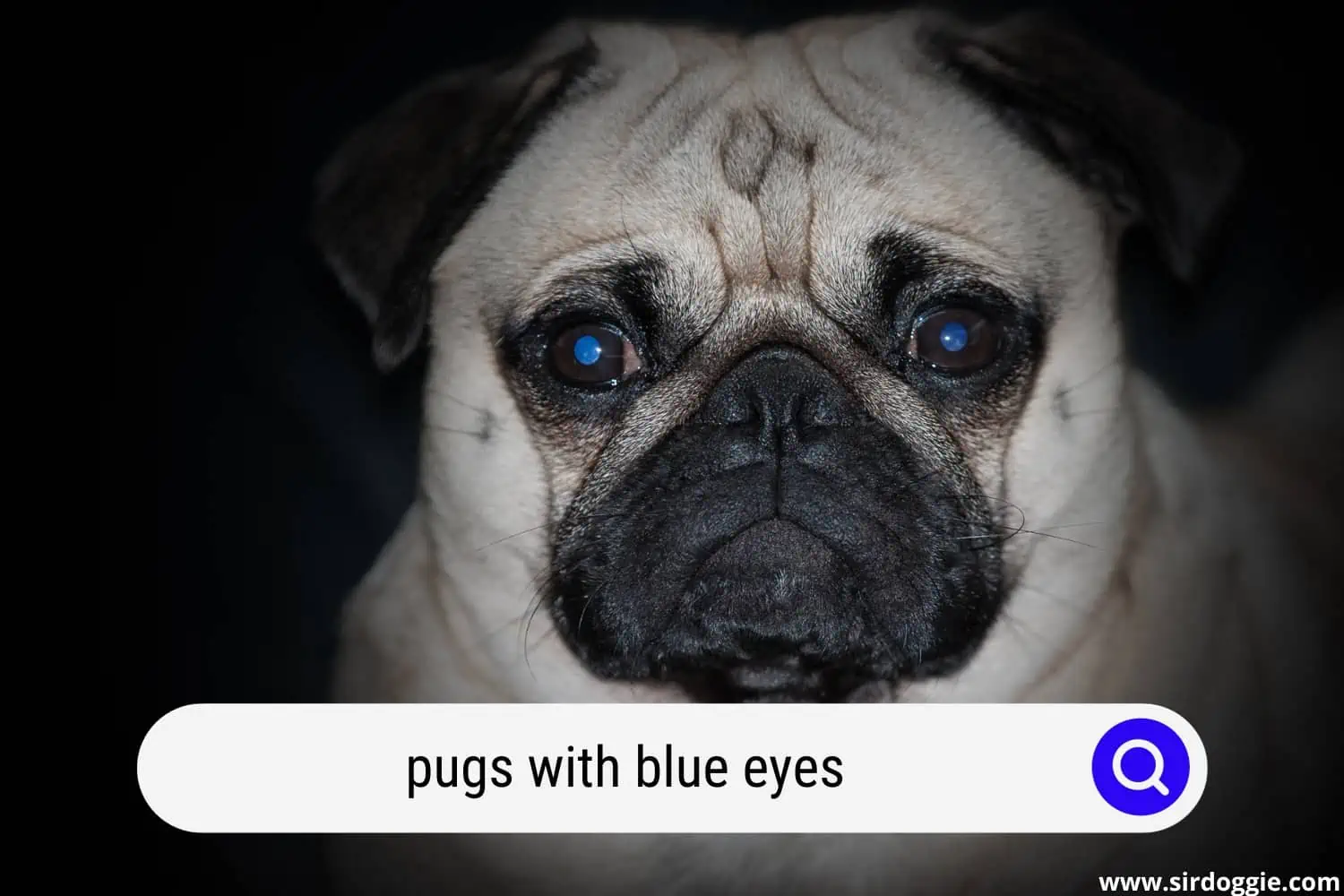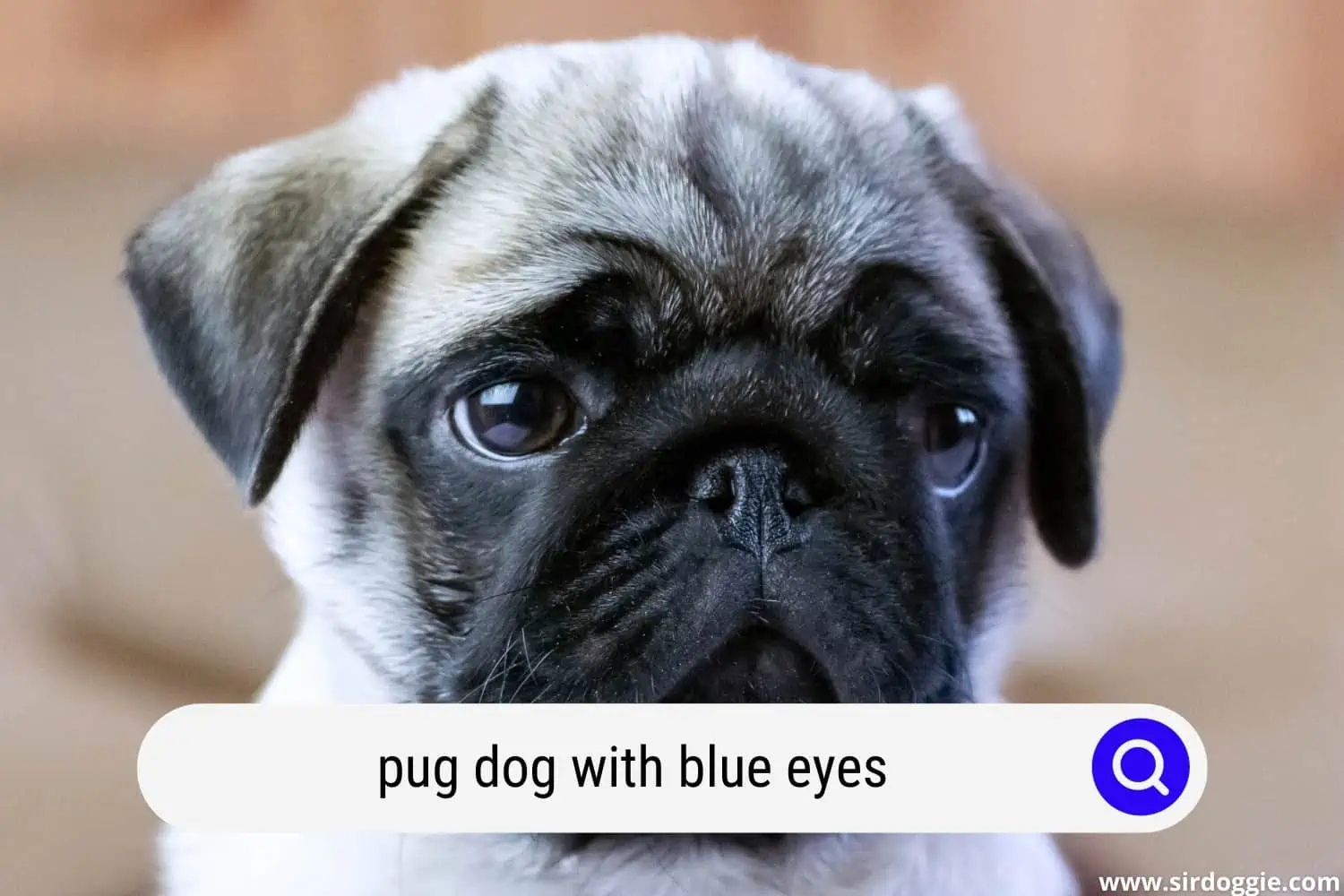Pugs With Blue Eyes – Is It Normal?
There are so many breeds out there in the canine world. They differ in size, temperament, health issues, coat, and even eye color. While the most common peeper shade is brown in dogs, there are also some blue-eyed canine members. Pugs are no exception to the rule. It is not necessarily a common occurrence, but Pugs with indigo eyes are out there and looking very cute.
But why are there Pugs with blue eyes? Before we take a look at a Pug breed specifically, let’s discuss why some canine companions are born with a unique eyeshade aside from the accustomed brown.

Is It Normal For A Dog To Have Blue Eyes?
It is not very common for hounds to have any other color eyes than brown. Unless it is “programmed” in their DNA. If you spot a pooch with a different, much lighter color peeper, it might be that they belongs to a specific dog breed known for various eye color options besides chestnut. Another reason: it could be some kind of an ongoing health issue. Let’s take a look at a few breeds that are often born with those unbelievable baby blues.
Breeds That Get Blue Eyes
1. Huskies
One silver-coated Russian beauty who takes your heart by storm with those piercing baby blues. Blue eyes are a genetic Husky trait that occurs when the iris pigmentation in the eye loses its strength. It causes that unique eye color Huskies are adored for. One lucky breed if you ask me!
2. Great Dane
A well-built German fella with some Irish mixed-in blood which is most likely responsible for its gorge sky-blue eye color. One interesting fact about the breed: as Great Danes age, the eye color changes to amber and more of a chestnut shade. That is a very peculiar finding taking into account that most canine peepers become much lighter with age (it is accurate for humans as well), not the opposite.
3. English Setter
A very proper and posh, like a true English gentleman, this breed is also known for those to-die-for-eyes. Although blue oculi are not always common among these graceful, lean dogs, when they do inherit them they become utterly irresistible. However, there is one sad fact that is linking both their eyesight and hearing: blue peepers almost always mean that the dog will be deaf.
4. Border Collie
Another very intelligent English gentleman who originated from the British Isles. It is considered a medium-sized dog, and it is known for what they call “heterochromia,” or “different colored eyes.” That is quite an intriguing trait: one eye could be, let’s say, blue while the other or brown. By the way, don’t think that dogs with this type of pigmentation have any eyesight problems. They can see perfectly well with both of their oculi.
5. Labrador Retriever
A very popular dog breed all over the globe and for some valid reasons. They are one of the most lovable, loyal, and witty dogs in the canine world. Their beautiful goggles come in a variety of colors, including indigo. The latter shade is not very common but does occur occasionally. When mixed in with the rich chocolate or golden coat color, the combo beautifully contrasts creating one very cute, charming pup.
Now, what about Pugs in particular, what are the instances of the Pugs with blue eyes phenomenon? It is a rather rare occurrence, but it does take place once in a while. Why? Let’s cover the most common reasons.
Reasons Why There Are Pugs With Blue Eyes
Albino Pugs
The white Pug species inherits the unusual for the breed’s azure eye color. The reason they are born this way is that they lack melanin pigment causing skin, hair, and eyes to be darker. Albinism does not only affect dogs but humans as well. Albino people have very light skin and are prone to various skin issues like sunburn, rashes as well as skin cancer.
There is no way to predict the albinism in Pugs: it may not show for a few generations in a row. One day all of a sudden a white Pug with blue eyes will be born. It is a disorder that is triggered by abnormal gene activity, causing color deformations.
Hybrid Pug Puppy
Those wrinkle-faced pups are crossbred with blue-eyed species, like Huskies for example. Interbreeding Pugs is a very common practice, aimed at reducing the customary health issues usually associated with all brachycephalic breeds. Some of the wellness problems include respiratory, heart, skin, and eye disorders. Hence, by mixing two different dogs, not only do you get a healthier dog, but also a cuter one.
Pugs with Various Eyesight Issues
For instance, cataracts, glaucoma, and worsening vision due to old age. As soon as you notice that your Pug’s eyes become much lighter in color, it is time to take it to the vet. A canine health specialist will be able to give you the exact diagnosis for lighter eye color and guide you on what steps to take to improve your fur baby’s eyesight.
Also, your blue-eyed Pug will need a special kind of care to protect its bright peepers from getting hurt. A pet parent should make sure that its Pug baby only walks when the sunlight is the weakest: very early in the morning and late at night. Otherwise, the strong sun rays are capable of injuring your pup’s irises and causing all sorts of eye problems. And it’s no fun for the Pug pal’s sensitive skin to be exposed to the star’s radiation. It needs to be avoided in order not to cause any dangerous derma conditions.

Curl-Up
Blue Pug puppy eyes are more of a rarity rather than a customary trait. While having an azure eyeshade is super adorable, it doesn’t always mean that it is a normal condition. Sometimes a Pug with other than brown irises will be extra light-sensitive, have an albino syndrome, or just simply get old, as sad as that sounds. In any case, this kind of fella should be treated with extra care, and avoid prolonged sun exposure at all costs.
Read more about: Do Pugs Have Down Syndrome?

Family Dog Expert Author
Hi there! I’m Stuart, a devoted dog lover and family dog expert with over a decade of experience working with our furry companions. My passion for dogs drives me to share my knowledge and expertise, helping families build strong, loving bonds with their four-legged friends. When I’m not writing for SirDoggie, you’ll find me hiking, playing with my beautiful dog, or studying music.